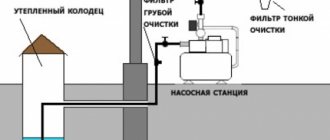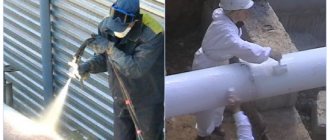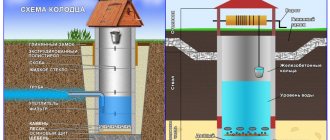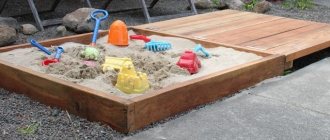Requirements for insulating materials
The modern market offers a huge range of different insulation materials. As a rule, they are suitable for outdoor and indoor use. But all types of insulation for external communications must meet the following requirements:
- Resistance to mechanical (static and dynamic) effects.
- Inert to humidity and low temperatures.
- Low thermal conductivity.
- Non-flammability.
- Low percentage of water absorption.
- Long service life.
- Resistance to attack by rodents.
- Possibility of DIY installation.
Advice: pipes need to be insulated at the stage of installing the water supply system. By the way, due to good insulation, the depth of the trench can be significantly reduced. And this is savings when performing work.
Interesting: How to make a drain from plastic bottles
Why do pipes freeze?
The risk of water freezing in the pipeline exists regardless of the material of manufacture. But in steel structures, active ice formation begins earlier than in plastic ones. This is due to the high thermal conductivity of the metal, which cools much faster in the cold.
Freezing of water in a pipe is observed at temperatures from -7°C. Provoking factors:
- laying the pipeline above the soil freezing level or in the open air;
- non-compliance with the slope, due to which the pipes are constantly in a filled state;
- improperly functioning taps, taps and valves that delay the outflow of water.
A very unpleasant phenomenon is pipe rupture, which is caused by the expansion of water during the transition from the liquid phase to the solid phase. In this case, you have to replace the damaged area, which is not the easiest thing to do in low temperatures.
Types of insulating material
For water pipes in the ground located outdoors, the following types of insulation are suitable:
- Glass wool. The main advantage of this material is its high porosity. This means that it retains heat perfectly. Unfortunately, glass wool also has a number of disadvantages. These include a high level of water absorption (including condensate), deformation under static loads. That is, over time, all the insulation will be compressed and will not retain heat. We will have to carry out insulation work again.
- Polyurethane foam. Easy to install, not prone to corrosion, lasts more than 10 years. Polyurethane foam can be used repeatedly. In addition, shells made of this material can easily be placed on a pipeline of any configuration. There are shells on sale with internal foil winding. They retain heat even more.
- Basalt shell (cylinders). The properties of the material are similar to polyurethane foam. Easy to install. However, the cost of basalt insulation is much higher. But the price of the material is completely justified.
Types of basalt insulation
- Polystyrene foam (expanded polystyrene). It can also be purchased in the form of mounting cylinders. The material is resistant to water, cold, and deformation. Keeps warm perfectly. Polystyrene foam can be reused many times.
- Synthetic rubber. It consists of sheets that are used to wrap the pipeline. Rubber has zero toxicity, is stretchable and can regain its shape. The material does not decompose. The only disadvantage of synthetic rubber is the need for additional fixation.
- Sprayed insulation in the form of paint or polyurethane foam. They are applied to the entire surface of the pipe and form a uniform sealed layer that protects the pipeline from the cold. The cost of such insulation will average $15 per linear meter.
Several layers of insulation
Water supply for a bathhouse in winter
A frequent and interesting question for many is the water supply of the bathhouse.
Winter water supply is installed in the bathhouse, as in the country house. But there are also some nuances. If the house already has running water, you can run water from it to the bathhouse. This is also done underground or by air, but using insulation and a heating cable inside the pipeline. The water supply only for supplying water to the bathhouse does not need to be insulated. The most important thing is to equip it with a slope and a drain valve. Don't forget to empty the water after use.
If the source of water intake is a well or a well, then the water supply for the bathhouse is built, as in the country house. With constant use, the pipes are buried in the ground; if rarely, the water is drained into the water intake source after use.
The water supply pipe that goes directly into the bathhouse must be insulated so that it does not freeze.
The video shows in detail how the installation of water supply for a bathhouse occurs in winter:
Electric cable
It is worth mentioning separately about the electrical cable. It allows you to insulate a water pipe so that it does not freeze, above the ground and in the ground. The cable is distinguished by the fact that it is able to turn on independently at a temperature of +3 degrees and turn off independently when the temperature drops. But subject to installing a thermal relay. Otherwise, the self-regulating cable will draw a lot of electricity.
Electric insulation is especially good for regions with harsh winters or for those areas where rocky terrain does not allow pipes to be laid below the ground freezing level.
Interesting: DIY plumbing in a private house
Laying pipes below freezing depth
The depth of soil freezing will depend on the characteristics of the local climate.
It is recommended to lay the pipeline in the ground without additional artificial heating when it freezes at a depth of up to 170 cm. Laying a winter water supply system with your own hands at the dacha looks like this:
- it is necessary to dig a trench 25 cm deeper than the freezing point;
- sand 10 cm thick is placed on its bottom;
- Next, a technical pipe is laid with a diameter larger than that of the water supply; thermal insulation must fit in it;
- a water supply wrapped in a special heat-insulating material is placed in it;
- The ideal solution would be to use a pipeline without connections in hard-to-reach places; this will protect owners from possible unplanned repairs and unnecessary financial costs.
It is important to prevent soil from getting inside the technical pipeline.
Among the pipeline materials, metal and its various alloys can be used, but low-density polyethylene is considered the most suitable. It does not corrode, freezes more difficult and clogs less.
If possible, the thickness of the pipeline walls should be as large as possible. The depth of soil freezing is calculated based on the temperature regime of the coldest days over the last decade.
Installation of insulation
The design of insulation depends on its type. So, all shell-type cylinders are put on the pipeline in parts. That is, two halves are joined. It is important to place them with offset seams. This will reduce the number of cold bridges. For greater reliability, you can cover the insulating cylinders with oilcloth on top and secure it.
If we are talking about glass wool, then the water pipes are first wrapped with such insulation, and then covered with roofing felt on top. This is necessary, since cotton wool strongly draws water from the soil and wrinkles under the influence of static loads. If it is not protected from water, then the insulation will very soon lose its thermal insulation properties. As an alternative solution, you can use plastic pipes of larger diameter to lay an insulated water pipeline in them. For example, these could be orange sewer pipes for outdoor use.
Advice: to protect the insulation from rodents that want to get closer to the heat, experienced craftsmen recommend coating the pipes with a mixture of cement and broken glass. Thin layer. Or wrap the communication with a special durable fine mesh.
Where to connect the winter water supply?
There are only three options here:
- from a well;
- when connecting to the central highway;
- from the well.
The most convenient and easiest way is winter water supply from a well. It has a number of advantages over the above:
- with inadequate care, water-bearing canals rarely become silted;
- no need for a powerful pump;
- during conservation, water can be drained directly into the well.
To drill a well, you need a decent amount of money, and its maintenance costs even more; therefore, winter water supply from a well is a profitable way to obtain hot water.
Winter water supply project
Without a project and diagrams, it is almost impossible to create a proper water supply system.
It is important to consider when creating a route design and the location of connections to the plumbing.
Here are examples of diagrams and projects you can use
Cable insulation
To complete the work you will need:
- Sticky mounting tape;
- Heating cable;
- Thermal relay;
- Scissors;
- Upper insulating shell (especially necessary when insulating external pipes).
The work process looks like this:
- Apply adhesive tape (foil tape) along the pipe lengthwise.
- Now start winding the cable in a spiral. The coil pitch should be smaller, the lower the power of the electrical cable. On average, for a 20 W cable, the turn pitch is 10-15 cm.
- A protective shell made of polystyrene or basalt is placed on top of the pipe. It is additionally tightly wrapped with tape to prevent moisture from getting inside the casing. That is, you need to cover all the joints of the cylinders with adhesive tape.
Now the water supply can be buried.
How to avoid freezing pipes
But what if it is impossible to bury the pipe below the freezing depth? For example, the site may have rocky soil that is difficult to develop. Also making it difficult to penetrate are structures buried in the ground - reinforced concrete slabs, foundations, communication routes that cannot be penetrated or bypassed.
The most common reason is high groundwater level. The soil on the site can be so damp that water begins to appear literally at a depth of two shovels. It is not possible to dig a 1.5-2 m trench and lay a pipe there.
Important. For these cases, various methods of installing a pipeline with insulation are provided. They will help prevent water from freezing even when laid at a very shallow depth.
Thermal insulation with “shells”
Manufacturers produce shells for pipe insulation from various materials - polyurethane foam, foamed polystyrene, mineral wool. PPU and PPS shells are used for laying in the ground. They reliably protect structures from freezing, do not rot, and do not corrode in a humid, aggressive environment.
For ease of installation, some products are equipped with a tongue-and-groove lock. An additional outer layer of foil reflects heat rays and reduces the likelihood of channel freezing.
“Shells” are produced in a wide range of sizes and shapes, so choosing suitable thermal insulation for communications, even of complex configurations, is not difficult. During installation, the shell is placed on the water conduit and additionally secured with fastening tape.
"Pipe in pipe"
This method is often used when laying pipes outdoors: at the entrance to the house or between nearby buildings, for example, a cottage and a bathhouse. The method provides not only good thermal insulation, but can also be useful if an ice plug has formed in the water supply. Hot water is poured into the gap between the pipes and patency is restored in a matter of minutes. Everything is convenient and practical - no need to look for a blockage or dig a hole in frozen soil.
For installation using the “pipe in pipe” method, non-pressure plastic sewer pipes with a diameter of 110 mm are used. The water pipe can first be wrapped with thermal insulation, and then inserted into the channel. A good insulating effect is achieved by using polyurethane foam (polyurethane foam), which is pumped into the gap between the pipes, having previously made holes along the length every 30-35 cm.
To minimize heat loss, the design is made even more multi-layered. It may consist not of 2, but of 3 pipes. If in such a “box” you additionally install thermal insulation from some porous material, for example, foam rubber or a substrate for laminate flooring, the pipeline will not freeze even in the most severe frosts.
Foil materials
Effective thermal insulation of water supply and sewerage systems - cylinders laminated with foil or foamed polyethylene films with a metallized layer. The materials reduce heat transfer to the surrounding space by reflecting infrared rays from the metal surface into the pipe.
The products consist of layers of insulation and aluminum foil. The thicker it is, the stronger and more resistant to damage. Mount the films with the foil side facing out. When laying, use a special metallized tape, carefully sealing all joints with it.
Heating cable
Cable pipe heaters are becoming increasingly popular in private buildings. They are installed both outside and inside water supply networks.
Laying can be carried out not only at the stage of laying communications, but also along already buried pipelines. This is often the most acceptable way to get rid of regular freezing without laborious dismantling of pipes.
To heat water supply and sewer networks, a polyolefin-coated cable is used, which is resistant to aggressive environments and mechanical damage. When laying wires inside the pipe, products with insulation made from food-grade fluoroplastic are used, which is safe for health and does not change the taste of drinking water.
According to the type of regulation, cables can be self-regulating or resistive, the latter can have one or two cores. The temperature regime and power level are selected depending on the pipe diameter and purpose.
Installation is carried out in the following ways:
- spiral winding;
- installation outside along the pipe;
- internal gasket.
Self-regulating cables are able to change the degree of heating with temperature fluctuations. The colder it is, the higher the power consumption of the product. Sold in coils of measured length, you can cut the required amount.
Resistive heaters have constant parameters that do not change depending on environmental conditions. Manufactured in fixed length sections. If you need to cut the conductor, you will have to apply the coupling yourself.
Important. When laying a heating cable, it is advisable to carry out insulation so as not to waste heat on warming the surrounding space.
In order to save energy, you can turn on the power only when the pipe lumen is blocked with ice, and do not use heating the rest of the time.
Video - installation of a self-regulating heating cable inside a pipe
Thermal insulation paint
Liquid insulators are new generation coatings. Thermal paint creates a thin protective layer on the surface of structures, replacing traditional insulation several centimeters thick.
This effect is explained by the very low thermal conductivity of the composition. It contains tiny balls of glass, ceramics or polymers with a vacuum inside, which effectively prevent heat transfer. The content of heat-insulating microspheres reaches 80%, the rest of the volume is occupied by an acrylic or latex binder.
The paint is applied with a brush to the surface of the pipe in several layers. According to manufacturers, the service life of the coating reaches 12-40 years.
Ready-made thermally insulated pipes
You can significantly simplify your task if you install pipes in a factory-made protective shell. Manufacturers produce products for plumbing, sewerage and heating installations with one or more functioning channels, as well as an additional heating cable. Insulated communications can be installed both outside and inside the house.
The corrugated coating provides design flexibility, which greatly simplifies the process of laying even complex pipeline configurations with a small radius of curvature. To avoid shell deformation, the installation technology provides for the installation of a soft sand cushion. A special adapter is used to connect to a regular pipe.
Recommendations for preventing water pipes from freezing
What can and should be done to prevent water pipes from freezing in winter? Only specialists can give a competent answer to this question. It is worth listening to their advice:
- Find the shut-off valve in the house in advance and report your finding to all adults living in the house.
- If you plan to move out of your country house for the winter, then drain the water from the system, turn off the taps and collect all the hoses.
- If all drainage systems on your site are located in a garage or shed, then the doors of these rooms should always be kept closed.
- If there are unprotected water pipes, you need to block any possible access of cold air to them - for example, plug all the holes with rags.
- It is not enough to insulate pipes in the ground; you need to take care of this in other places where the water supply runs - many people also have it in the attic.
- In case of severe frosts, you need to lay a heating cable along the pipes - ideally, this should be done along the entire length of the water supply, but it will also be enough to protect the “weakest” areas.
- In the winter season, when frosts are predicted, always keep the tap slightly open - let the water drain from the system slowly. If you see that the water has stopped flowing, this means that ice has appeared in the pipes - open the water more, it will force the ice that has already formed out of the pipes.
If you follow all the above recommendations, then no freezing will occur even in the most severe frosts.
Insulated pipes must be returned to their original position after the end of winter:
- firstly, you need to remove all heating devices and heat-insulating materials - overheating of the water supply is also harmful to the system;
- secondly, it is necessary to examine the condition of the water supply and drainage system - even with apparent prosperity, damage may be detected;
- thirdly, it is advisable to reconstruct the system and eliminate the possibility of water pipes freezing next winter.
Insulating the water supply is a direct path to joy from frost and sun. But if you haven’t taken care of this process in advance, you will have to resort to one of the methods recommended above to defrost the water supply.
( 73 votes, average: 4.75 out of 5)
Frame country house: how to build it yourself on a turnkey basis
How to make a metal garage with your own hands
Related Posts
Do-it-yourself insulation of a water pipe on the street
Insulating a water pipe on the street is a very important and responsible process. Experts say that if the pipe is installed above the ground, then it must be insulated. Pipe insulation is necessary especially in winter, when severe frosts can occur. This is where the question arises about how to insulate a water pipe. People who have never encountered such a problem begin to run around looking for a universal, durable insulation that can be easily installed. In specialized construction stores there are quite a lot of insulation materials that differ from each other. Therefore, when choosing insulation, it is necessary to take into account its characteristics.
So, in the first place is fiberglass insulation. This material is popularly called glass wool. It is used to insulate PVC pipes for external sewerage. Today, several well-known construction companies are engaged in the production of such insulation, which guarantees the quality of the product. Using fiberglass material, you can insulate both metal and metal-plastic pipes. The main disadvantage of insulation is its low density. This means that when insulating glass wool, it is necessary to use additional materials, such as roofing felt and fiberglass. Naturally, more money will be spent on such comprehensive insulation than expected. But if you still choose glass wool, then it’s better not to skimp on insulation. Insulating an outdoor water pipe using fiberglass material is good because the insulation has good flexibility, which allows it to be used on curved pipes.
After the fiberglass material comes basalt insulation, which includes basalt fiber. The material has a cylindrical shape. The main advantage of the material is that it is very easy to install. In order to carry out installation quickly and easily, it is necessary to select the correct diameter of the insulation cylinder. When using this insulation, there is no need for any preparatory work, which greatly simplifies the insulation process. The main and probably the only disadvantage of a basalt cylinder is its high cost. But most people believe that the high price is quite rightly set, since the material is a very effective insulation. Today, basalt insulation is produced with a protective layer. Roofing felt, foil, and glassine are used as protective materials. Installing such material is very simple, which allows even inexperienced people to carry out the work.
Insulation of a water pipe on the street is also carried out using a shell, which consists of foam plastic. The shell is produced both with and without a protective layer. The advantages of this insulation are the low price of the material and the ease of its installation. In fact, foam shell is one of the cheapest insulation materials. Also, this material can be easily removed and reinstalled. This opportunity is considered a great advantage, since sometimes there is a need to repair a water pipe, and buying new insulation every time is very fraught. Given such a variety of insulation materials, the main stage of thermal insulation is the choice of material.
Where to start
To carry out excavation work, first of all, it is necessary to decide on the excavation technology, which includes manual and mechanical methods.
When digging a trench for a water supply, they mainly use special equipment - manual excavation of large volumes of soil is not economically feasible, it takes a lot of effort and time and costs 2 times more if they hire outside workers rather than try to dig a ditch with their own hands.
To lay a pipeline at shallow depths of up to 1 meter, household walk-behind tractors with special belt (chain) attachments, trenchers or soil cutters with small dimensions and weight are used, the width of the ditch is 15 - 20 cm. When using special equipment for digging trenches - bar, those carrying out soil extraction using a belt or chain mechanism with blades, reach an excavation depth of up to 2 meters with a channel width of about 30 cm.
If the water supply is buried at a distance of more than 2 meters, the parameters of the width and depth of the trench increase; mini-excavators used for digging to great depths form a ditch about 50 cm wide.
Rice. 6 Special equipment for digging trenches: walk-behind tractor, trencher, bar attachment, mini-excavator
Protection of sewerage, household appliances and irrigation systems
- Sewer pipes in their normal state are not filled with water, so you don’t have to worry about them. Remaining water must be drained from the bends of siphons, from washing machines and dishwashers.
- The pipes of the summer irrigation system usually either lie on the surface or are shallow, so they also need to be emptied.
- Drip irrigation tapes are removed, rolled into coils and stored for storage; the same can be done with removable irrigation hoses.
- If the system is laid with pipes, then a drain valve must be installed at its lowest point. The same valve is installed on slightly recessed lines. But there is always the possibility that there is a slight sag somewhere in an invisible part. Therefore, it is customary to additionally purify such systems using compressors. There are companies specializing in providing this service. But if you have a compressor, you can do this work yourself. Blowing is done until water stops flowing out of the drain hole. But after the first blowing, you should wait a little and repeat the procedure, because the remaining water on the inner walls of the pipes gradually drains and accumulates in the lower sections of the curved pockets.
- A large storage tank may not burst due to frozen water in it, but it is better not to risk it and empty it too.
- Injection pumps and automatic valve water distribution systems should be dried and stored.
Distance between two pipes underground
As noted earlier, building codes do not allow the placement of water supply and sewer lines in the same or different trenches if the distance between them is less than 1.5 meters; this rule applies to industrial and domestic water supply lines.
Also, construction regulations (clause 9.6 of SNiP 41-02-2003) allow the joint installation of water supply and heat communications in one trench. When laying a water supply and cable electric line in parallel with a voltage of up to 35 kV, the permissible distance between them is at least 1 meter (electrical installation rules PUE-7 clause 2.3.88.), if the electric cable crosses a water supply system, the distance at the crossing point is at least 0 .5 meters.
Rice. 9 Electrical cable - installation diagram
- Reading about how deep to bury a water pipe in a private house, you may be interested to learn about the security zone of the water supply and sewerage system










